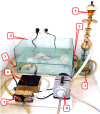The Effect of Waterpipe Tobacco Smoking on Bone Healing Following Femoral Fractures in Male Rats
- PMID: 34671637
- PMCID: PMC8520932
- DOI: 10.3389/fsurg.2021.722446
The Effect of Waterpipe Tobacco Smoking on Bone Healing Following Femoral Fractures in Male Rats
Abstract
Background: Given the increasing use of waterpipe tobacco smoking in the world and its unknown effects on bone healing, this study investigated the repairing of femoral bone fractures in rats exposed to waterpipe tobacco smoking (WTS). Main Methods: This study involved 40 male Wistar rats that were divided into two groups, including the femoral fracture (Fx) and the Fx + WTS groups. Each group was divided into two subgroups that were evaluated for bone healing 28 and 42 days after femoral fracture. After fixing the fractured femur, the healing process was evaluated by radiography, pathological indicators, and a measurement of the blood levels of vascular endothelial growth factor (VEGF), parathyroid hormone (PTH), Ca ++, transforming growth factor-beta (TGF-β), and insulin-like growth factor 1 (IGF-1). Additionally, the density of VEGF and CD34 in fracture tissue was investigated by immunohistochemistry. Key Findings: Radiographic findings showed that factors related to the earlier stages of bone healing had higher scores in the Fx + WTS28 and 42 subgroups in comparison to the Fx groups. The density of VEGF and CD34 showed that the angiogenesis processes were different in the bone fracture area and callus tissue in the Fx +WTS subgroups. The serum levels of VEGF, TGF-β, and IGF-1 were significantly lower in the Fx +WTS42 group, and PTH in the Fx +WTS28 group was higher than that in the other groups. Significance: The findings showed the disturbance and delay in the femoral fracture union in rats exposed to hookah smoke. This is partly due to the reduction of molecular stimuli of bone synthesis and the attenuation of quantitative angiogenesis.
Keywords: TGF-β; angiogenesis markers; femur fracture; insulin growth factor-1; union; waterpipe tobacco smoking.
Copyright © 2021 Sadeghifar, Sheibani, Joukar, Dabiri, Alavi, Azari, Vosoghi, Zeynali, Zeynali, Shahraki, Torghabe, Rostamzadeh and Nasri.
Conflict of interest statement
The authors declare that the research was conducted in the absence of any commercial or financial relationships that could be construed as a potential conflict of interest.
Figures












Similar articles
-
Human parathyroid hormone (1-34) accelerates natural fracture healing process in the femoral osteotomy model of cynomolgus monkeys.Bone. 2007 Jun;40(6):1475-82. doi: 10.1016/j.bone.2007.01.015. Epub 2007 Feb 2. Bone. 2007. PMID: 17369013
-
The effect of femoral nerve block on fracture healing via expressions of growth factors and β-catenin.Folia Histochem Cytobiol. 2016;54(3):151-158. doi: 10.5603/FHC.a2016.0017. Epub 2016 Sep 21. Folia Histochem Cytobiol. 2016. PMID: 27654016
-
Exposure to Secondhand Smoke Impairs Fracture Healing in Rats.Clin Orthop Relat Res. 2017 Mar;475(3):894-902. doi: 10.1007/s11999-016-5184-6. Epub 2016 Nov 30. Clin Orthop Relat Res. 2017. PMID: 27905059 Free PMC article.
-
Severe Hemorrhagic Shock Leads to a Delayed Fracture Healing and Decreased Bone Callus Strength in a Mouse Model.Clin Orthop Relat Res. 2017 Nov;475(11):2783-2794. doi: 10.1007/s11999-017-5473-8. Epub 2017 Aug 9. Clin Orthop Relat Res. 2017. PMID: 28795328 Free PMC article.
-
Parathyroid hormone (1-34) promotes fracture healing in ovariectomized rats with type 2 diabetes mellitus.Osteoporos Int. 2017 Oct;28(10):3043-3053. doi: 10.1007/s00198-017-4148-3. Epub 2017 Aug 14. Osteoporos Int. 2017. PMID: 28808745
Cited by
-
The effectiveness of a theory -based health education program on waterpipe smoking cessation in Iran: one year follow-up of a quasi-experimental research.BMC Public Health. 2024 Mar 1;24(1):664. doi: 10.1186/s12889-024-18169-7. BMC Public Health. 2024. PMID: 38429705 Free PMC article.
-
The impact of surgeons' experience and practice on postoperative cervical collar use after single-level anterior cervical discectomy and fusion: a cross-sectional survey in Heilongjiang province, China.BMC Musculoskelet Disord. 2025 Jul 4;26(1):647. doi: 10.1186/s12891-025-08880-w. BMC Musculoskelet Disord. 2025. PMID: 40616052 Free PMC article.
References
LinkOut - more resources
Full Text Sources
Miscellaneous

